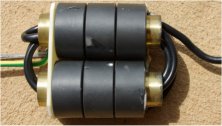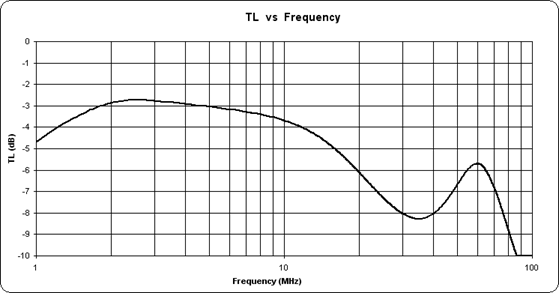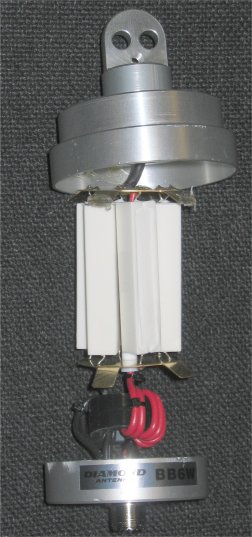Copied from G8JNJ's Web.Archive.org
All material presented on this page copyright G8JNJ
Some time ago I started investigating broadband antennas that could be used without a tuner. My initial experiments were based on the principle of using an 8m vertical, with a 4:1 impedance matching transformer at the base. This presents a reasonable match on most HF bands, but it still requires a tuner to bring it within acceptable operating limits for modern HF transceivers. This problem can be overcome by adding a 3dB high power attenuator on the input of the matching transformer. However the resulting losses due to the resistive attenuator, and the impedance mismatch it is masking, results in very poor performance on several bands. Typically 6-12dB worse than when being fed with an Auto-Tuner.
These tests made me wonder if any of the commercial broadband antennas would work any better ?
Note:- if you are seriously interested in building an efficient broadband vertical antenna, please see this website which details a new type of design with significantly better performance TC2M Antenna
Iain, VK5ZD, posted some interesting information regarding the internal construction of the Comet CHA-250B broadband vertical antenna. The notes can be found here.
Following e-mail discussions with other amateurs, I now understand that the Comet HA-750BL Comet VA-250 use similar principles of operation, and are based upon a design which originally apeared in the Japanese magazine CQ ham radio
The Diamond BB7V and BB6W (see lower down this page) also use a lossy Unun but incorporate a resistive load, rather than using part of the Unun winding to provide this function.

Photo of inside the original Comet base matching unit
My conclusions at this early stage were that the commercial model used a lossy 6:1 impedance transformer, which was unlikely to produce much better results than those obtained with my 4:1 balun and attenuator. However as can be seen from the chart such designs can work reasonably well on some frequencies, and would permit contacts to be made, but at a level of approximately 1-2 S points (6 to 12dB) below that which could be achieved with a similar sized resonant vertical. Optimisation of the antenna and balun may produce slightly improved performance, but it is unlikely to be noticed on the air.
Further analysis of the transformer revealed that it actually consists of two separate transformers with inter-coupled windings. This technique is used in conjunction with a single ?feedback? winding on one of the transformers. This ?feedback? winding seems to be used in order to optimise the performance at the low frequency end of the operating range. The overall result is a complex design which is quite difficult to interpret. The second transformer seems to form a network, which in some way improves the match at specific frequencies, possibly by introducing an additional series impedance.
Owen, VK1OD, has performed his own analysis of the CHA-250 matching transformer, which can be found on his website
In operation the two separate transformer sections add loss at different frequencies. The low value of resistive shunt impedance present in the input transformer (transformer two in the diagram below) adds loss on the low frequencies. The second transformer section (transformer one in the diagram below) adds loss on the high frequencies.


This can be clearly seen in this thermal image. Where a 50w CW signal has been applied on 3.6MHz (LF) and on 29MHz (HF).

In order to better understand how the antenna operated, I decided to build a copy of the transformer. Lots of correspondence was exchanged with Iain, most of which he has documented here. I made several versions of the transformer used in the CHA-250B antenna with different transformer cores. I tested many different types until I found a suitable material. Which I compared against Iain's measurements.

The original construction was based on a series of photos taken by Iain, VK5ZD, which can be found on his website
Photo of Comet transformer (Bottom) and my version (Top).
.jpg)
Here are some gain measurements I made of the CHA250 (1) and my version (2) feeding a 7m vertical and compared against a 1/4 wave vertical.

I made this measurement with all the antennas ground mounted and fed against 16 mixed length buried radials.
In order to minimise any slight mismatch problems with the transceiver across the wide frequency range I fed all the antennas via a 3dB power attenuator at the base.
The CHA-250 was compared against 1/4 wave verticals cut for each band mounted in the same position (except for 1.9 and 3.6MHz where I had to calculate the value from measurements made on a 10m antenna).
All levels were measured with a spectrum analyser connected to a 1m diameter balanced loop with a 3dB attenuator at the feed point, and mounted approx 10m away from the antenna under test.
Note that the gain figures at 28 / 29 & 50MHz are partially affected by the gradually increasing angle of radiation, due to the vertical element becoming much greater than 1/2wave long. The gain figure at 50MHz is slightly improved by the transformer having about 2dB less loss than at 28/29MHz.
Note that these gain figures should only be used as a guide, as these measurements were made in urban environment, not on a professional test range. It is worthwhile comparing them against the graph which appears further down this page, showing a gain comparison against the same length vertical fed with an Auto ATU.
Construction
Note that the first part of the secondary winding is on the outside of the core, and that the final winding is fed back on its self through the transformer core.

Here's a slightly cheaper version to build. It's smaller but will only handle about 100watts of SSB.
.jpg)
This graph shows the output impedance of the transformer, with the input terminated in a 50 ohm load. This was measured with an AIM 4170 and graphed using ZPlots

The impedance values of both the original Comet transformer and my version are very close to each other.
The Black curve shows the overall Impedance.
The Blue curve shows Resistive part of the Impedance
The Red curve shows the Reactive part of the Impedance
Next the loss through the Comet transformer. I obtained this by measuring two transformers back to back, and then halved the loss values to give the figure for one unit. This was measured with a MiniVNA and graphed using ZPlots

Note that this loss is fairly high and would produce a VSWR of around 5:1 over most of the frequency range even with no antenna element connected.
I also wanted to see what the loss curve looked like when feeding a variety of different load impedances. In order to obtain these measurements I used the MiniVNA connected to the transformer via a selection of different ratio Ununs.

The traces show the measured loss (including the Unun). Each colour represents different load impedance.
Red - 450ohm load
Yellow - 200ohm load
Green - 50ohm load
Blue ? 12ohm load
Black - 6 ohm load
It should be noted that the measured loss figures are only valid when terminated with suitable load. This is not the case when the transformer is connected to an antenna element, which will have varying impedance across its operating range. In this case the loss could be much greater or less than the measured values. So the only way to try and evaluate the performance is by making on-air measurements.
The following graph shows the performance of various antennas relative to a reference antenna consisting of a 10m vertical connected to an auto-tuner at the base of the antenna and fed against 10 random length buried radials. In addition to the Comet clone I also tested an improved version of the transformer (which I?ll describe later) and also a good quality 4:1 Unun connected to a coax fed auto-tuner at the radio end of the cable (this is typical of how many unloaded vertical antennas are configured).

As can be seen from the graph both broadband tuner-less designs work quite well. In fact it?s only at the low frequency end of the operating range that the 4:1 Unun and remote tuner are significantly better. My improved version of the transformer and antenna are described on this page
This was a real surprise, as most experts recommend using a 4:1 transformer when a tuner is used remotely in order to reduce the matching loss from the coax under poor SWR conditions.
What I hadn't realised was just how much additional loss can be introduced when the secondary of the 4:1 Unun is not matched correctly, or when Iron powder cores are used. See my general notes on balun construction and problems with Iron powder cores. This is effect is particularly noticeable at 1.9 and 3.6MHz where the base impedance of the 7m vertical has a very low resistive component and a very large capacitive reactance, which results in significant additional loss.
As a further part of this research I took another look at the reviews for the CHA-250 on eham, as I couldn't understand why some folks got good results with the antenna and others seemed to have really bad ones.
My measurements seemed to demonstrate moderately good performance, so I thought I would model an elevated feed in EZNEC.
Note that the following gain / elevation plots do not include losses associated with the Comet matching transformer. They are shown to illustrate how different mounting arrangements can affect the performance of the antenna.

Elevation plot showing antenna mounted on top of 6m metal mast 50mm dia. Base insulated from ground.
It turns out that the support pole I used 6m long 50mm dia and standing on concrete (so partially insulated from earth) is almost ideal in terms of the radiated elevation angles. This seems to be because the whole antenna operates in a manner similar to centre fed vertical dipole.
If you look at the plot below, showing the same antenna but with the bottom of the support pole connected to ground, you will notice that the angle of radiation steadily increases with frequency, resulting in a lot of the transmitted power being wasted.

Elevation plot showing antenna mounted on top of 6m metal mast 50mm dia. Base connected to ground.
So grounding the base of the mast seems to makes matters worse. I guess I just got lucky with the arrangement I used for my trials. This data would suggest that the length and type of support structure, plus decoupling of the coax at the correct length may have an important part to play in obtaining the best results.
Schematic diagram of the basic antenna configuration as suggested by Comet.

As further research I wrote emails to people who had posted bad reviews for the Comet CHA-250 on eham. The purpose of this was to try and determine if there were any common factors associated with the antenna installation which could affect the performance.
From the replies I received and further analysis of reviews I concluded the following:-
The main problem would seem to be the suggestion that the antenna will work with no radials, ground plane or counterpoise wires. This means that if none of these are installed, the antenna will use the coax cable as part of the radiating structure. This can result in very unpredictable results. I would strongly suggest that some form of ground plane is used. Either ground mount the antenna and connect at least 4 radial wires to the outer screen of the coax at the base of the antenna, or if the antenna is mounted on a pole, add a minimum of three sloping radials (at least 5m long) as this can dramatically improve the performance.
Many people had unrealistic expectations of antenna performance, especially on 3.6MHz where comparisons were made with dipoles, frequently for medium distance contacts. The antenna is electrically short on 3.6MHz so even if an auto-tuner is used the performance will still be 3-4dB down on a 1/4 wave vertical (20m high). The loss in the matching transformer at this frequency reduces the gain by a further 13dB, so the total gain at 3.6 MHz is about 17dB less than a 1/4 wave vertical. The other factor is the lack of NVIS coverage which makes a big difference for semi local contacts on 3.6MHz.
Other people made comparisons with vertical antennas such as the SteppIR BIG IR or Array Solutions Zero Five with these antennas the installation instructions give advice regarding good practice. There is nothing magical about these antennas. But if the installation instructions relating to earth radials, grounding, feed line routing etc. were applied to other vertical antennas perhaps more people would experience better results.
Another set of comparisons were made against antennas such as the Solarcon I-Max 2000 this is a 24 ft CB base station antenna which has a wideband matching arrangement permitting operation over the 18-29MHz frequency range. I estimate that the Comet antenna has about 15dB less gain than the Solarcon at 29MHz, 7dB less at 24MHz and 6dB less at 21MHz. This will result in a loss of some contacts, particularly on the higher frequency bands where interference and other background noise is low, making weak signal operation possible. This is not the case on the lower frequency bands in an urban environment, where noise tends to mask very weak signals. In some cases the received signal to noise ratio can appear to improve when using a lower gain antenna. However in many instances this is just a psycho-acoustic phenomenon, which can be replicated by switching in a similar value of attenuation on the receiver.
In conclusion I would say that the antenna is capable of reasonable performance, especially if some form of counterpoise or radials are deployed. Apart from operation on 3.6MHz the performance is comparable to using the same height vertical with a 4:1 Unun coax fed from a remote tuner. The only way to further improve the performance would be to use an auto-tuner at the base of the antenna, and add more radials.
If you are considering spending this amount of money on an antenna such a the Comet CHA-250 don't wish to build your own version. I would suggest that vertical wire supported by a 10m fishing pole with something like a CG-3000 auto-tuner at the base, may be more cost effective and a better performer, especially on 3.6MHz. However in some applications the advantage of having a broadband antenna and the ability to rapidly change operating frequencies may outweigh other considerations. Personally I have found this type of antenna very useful for general monitoring purposes and WSPR operation where it has provided exceptional results.
I?d be very interested to receive more information from other people who are trying similar antennas. I would also very much like to obtain a Maldol MFB-300 matching unit to experiment with. Damaged or broken ones would be considered, so please drop me a line if you can help.




.jpg)
.jpg)
.jpg)
